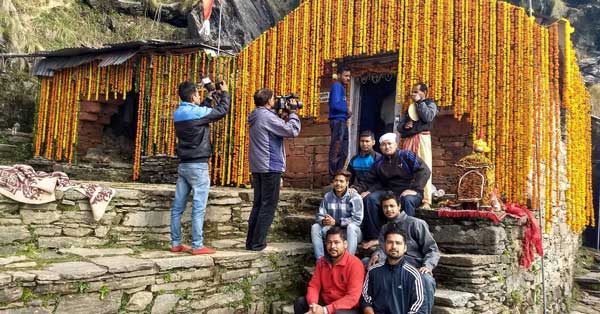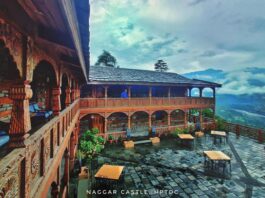Rudranath is a place that many people aspire to visit but seldom get the chance to see because it is a far-flung temple in Garhwal, Chamoli District of Uttrakhand. To say the trek is challenging would be an understatement, as a long, arduous 22 km journey can only take them to Rudranath temple.
If I were to describe it in a word, the experience would be unique. Trekking to the Rudranath temple is an out-of-this-world trek regarding the stunning views you get along the way, thanks to the deep gorges that make this area so impressive.
Rudranath is often deemed the toughest temple to reach out of the Panch Kedar. Still, if you ask me, it is worth the pain as one can see the glorious Nanda Ghunti, Nanda Devi, Hathi Parbat, Devasthan, and Trishul peaks.

There is just something too mesmerizing about the experience Rudranath has to offer. The thick bushy green woodlands, the wild grassy lush alpine meadows, and the views of the Himalayas that leave you awestruck are something to marvel at for hours on end.
Panar Bugyal is one of the most beautiful spots on the trek with its lovely flower-strewn meadows. It also has a waterfall and some temples nearby.

It is best to visit this blissful spot in the summer, from April to June, with the pleasant weather since the winters remain chilly and even harder to bear. Snow often blocks the road, making the hike impossible, usually between October and February. Still, the monsoon, which begins in July and lasts till September, may also make it difficult to reach the place with its rains.
Dedicated pilgrims find a way to complete their pilgrimage this season; some even consider it the best time to visit. This is because, during the month of “Shravan” (i.e., July-August), there is an annual fair on the full moon day mainly attended by the locals.
At Nandikund, devotees worship historical swords that protrude from the rocks that are believed to be of the Pandavas. The trek to Rudranath might be tedious and intimidating at times, but it feels all the more rewarding.

The Journey to Rudranath Temple
The origin point of this 3rd temple in the Panch Kedar series starts from Gopeshwar.
Gopeshwar is the winter abode of Lord Mahadev, In the months of winter, from November to March, It is the seat of Mahadeva, and all the worship and rituals are offered here.
One has to start from the Sagar village, which comes from the name of an old local King of Gopeshwar and has to trek uphill. The trek from Sagar to Rudranath is around 17 km uphill and then 2 km downhill. I will include all the details and intricacies of this trek, including resting spots, foods, and best practices.
When we start from Sagar village, the path is surrounded by small stone roofed typical mountainous houses. The course has markers to guide you on the way, and you don’t lose the way. A stick is always helpful while going upwards on the trek. It saves energy and helps in moving up.
The artsy hues of the sky may enchant your soul and make you not stop while walking up, You may fall out of breath, but mountains love to hypnotize people, even though it is not always about love.
There is greenery, and you might also find mountain cows playing with their herd. Mountainous women have a hard life, like the journey you are going to. Most women work in the mountain fields and collect fodder and wood.
After 2 km from Sagar comes Chandrakoti village, the first resting point up the hill. Chandra was the name of the wife of King Sagar. Since this is a long trek, you will find that the stalls and restaurants arrange the visitors’ sleep and resting places. While in Chandrakoti, do not forget the fantastic Buransh Flower juice at the resting point.
We can quickly feel the cold climate uphill when we move up while the sun plays hide and seek with the clouds. As we move up, the climb gets more brutal, partially because the legs accumulate lactic acid and partially because of the stony path. After 4 km of the climb, we find another resting spot, Pung Bugyal.
Many people stay here for the night. We must know that the ‘Bugyal’ is a term for an alpine meadow; these are the plains situated on the top of a mountain. Wild animals surround this place, and the sounds of growling are generally there at night. It would help if you did not forget to eat Lengda or Pahadi Bhindi here.
After this comes the 4th resting point called Lwiti. Lwiti is the best place if you reach here in the evening. The sky’s colors and the mountains’ ranges look pretty. This is a better place if you want to stay up the hill than Panar Bugyal as it is not as chilly, spine-freezing as the latter. There are some trees with Red-colored flowers here.
The next stop on the way is Panar Bugyal; most of the crowd likes to spend their nights at this point, But again, Lyuti is a better way to survive at night. While moving up for the Panar Bugyal, you pass through a dense forest with leaves on the floor and small brooks producing excellent music. While going up the hills, one can surely meet some deer running and playing on the grass.
A yellow-colored flag bearing welcomes you at the Panar bugyal; this is the first point where the snow-laden mountains are visible. Since snow is there, the path is slippery, and it is advisable to tread forth the way real slow.
This windy place is a meadow with snow often frozen in some parts; due to the excellent quality grass; some Pahadis like to bring their sheep to feed here. This is where the views of Nanda Devi, Trishul, and Nanda ghunti are accessible. The combo of Toli taal and Nanda Devi produces an astonishing view from Nature’s lap.
The next stop is Pitrdhar, the highest point in the Rudranath trek. It is said that people pray here for their ancestors. The descent starts from here to reach the Rudranth Temple. Also has Panchganga, there used to be a confluence of 5 small streams here, but now the streams have vanished.
Now comes Devdarshani; it is the point from where you can see the Rudranath temple directly. This is also the place having washrooms. The final destination is 22 km from Sagar, and you reach Rudranath. Do not forget to chant Har Har Mahadev once you reach the destination; the blessings of the Lord have brought you there.
The story of Rudranath Temple

After winning the glorious battle of Mahabharata and killing their brothers, relatives (Gotra-Hatya), Gurus(Brahma-Hatya), and much more, Pandavas took up the path of penance.
Though the war was fought for righteousness, the killing is yet killing.
So, to wash their sins, Pandavas started a pilgrimage to Lord Mahadeva to wash their sins. Lord Mahadeva, incensed by the dishonesty and death caused, wanted to avoid them. So he disguised himself as Nandi, the bull, and disappeared into the ground with different body parts appearing in other places. This is among those five places where the Lord’s visage appeared.
The temple of Rudranath
The temple is built from rock-cut in a Himachal style architecture. The bliss of Aarti at eight in the morning and at 6:30 in the evening makes it unique.

The ‘water of salvation’ of the sparkling Vairtarini (also sometimes called Baitarani or Rudraganga) and its whispers leave you spellbound. Other water bodies that bless this sacred land include Surya Kund, Chandra Kund, Tara Kund, and Manas Kund.
Panar Bugyal is one of the most beautiful spots on the trek with its lovely flower-strewn meadows. It also has a waterfall and some temples nearby.
You must take blessings of the Pujari Ji, Mr. Harish Bhat Ji. He will explain what Ekanana, Chaturanana, and Panchanana mean. Here, Lord Mahadeva’s Ekanana form is worshipped.
Do’s and Dont’s
- Take a stick with water bottles to keep you hydrated and a portable charger.
- Please be sure that there will be a chilled climate up there, so take your woolen clothes accordingly.
- Do not overeat; take rests on the way. Do not eat any random fruit you see on the way.
- Keep the mountains clean, Do not throw your plastic and other wastes to spoil the natural beauty.
Any questions? Please leave them in the comment section below.




